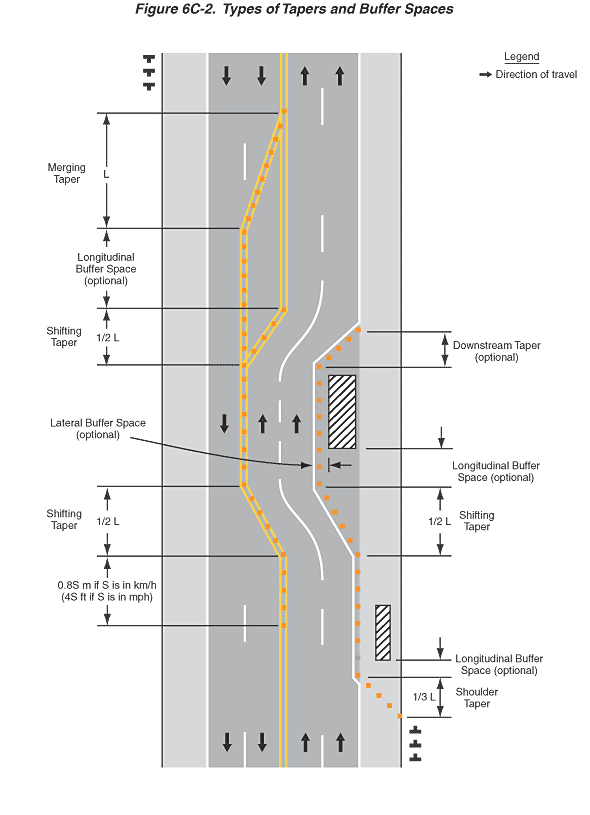|

Figure 6C-2. Types of Tapers and Buffer Spaces
This figure illustrates types of tapers and buffer spaces.
The figures shows a vertical divided highway with two lanes in
each direction. A legend shows a black arrow indicating the direction
of travel on the roadway lanes. Black arrows denoting the direction
of travel are shown in the right lanes pointing upward and in the
left lanes pointing downward. A double yellow line is shown separating
the opposing lanes. A broken white line is shown separating lanes
in the same direction. A shoulder is shown to the right of each
right lane. Each shoulder is shown with a solid white edge line
pavement marking separating the shoulder from the right lane in
each direction for the length of the figure.
At the bottom of the figure, to the right of the shoulder, three
upside-down T-shaped symbols denoting signs are shown, placed one
behind the other. Beyond these symbols, there is an area labeled
"Shoulder Taper." The length of the shoulder taper is
shown as a dimension of 1/3 L. In this area, beginning at the far
right edge of the shoulder, a series of equally spaced orange squares,
denoting channelizing devices, taper in to the white line separating
the shoulder from the right lane.
Directly above the shoulder taper, traveling upward, an area labeled
"Longitudinal Buffer Space (optional)" is shown, in advance
of a rectangular area with diagonal lines within the rectangle,
denoting a work space, on the right shoulder. Along the right edge
of the right lane, the equally spaced orange squares continue from
the shoulder taper, and the solid white line separating the shoulder
from the lane shifts to the left so that it is to the left of the
equally spaced orange squares. Across from the work space, equally
spaced orange squares are shown in a straight line along the double
yellow line between the opposing lanes. The orange squares continue
straight past the work space for a distance shown as a dimension
of 0.8S m if S is in km/h (4S ft if S is in mph).
Directly above this area traveling upward, an area labeled "Shifting
Taper" is shown as a dimension of ½ L. In this area,
the equally spaced orange squares and the solid white line separating
the shoulder from the lane are drawn diagonally from the right edge
of the roadway across the entire right lane to the broken white
separating the right and left lanes. The equally spaced orange squares
and the double yellow line between the opposing lanes also are drawn
diagonally across the left-hand opposing lane.
Directly above the shifting taper traveling upward, another area
labeled "Longitudinal Buffer Space (optional)" is shown
in advance of a rectangular are with diagonal lines within the right
lane, denoting a work space. The portion of the closed right lane
that is to the left of the work space and to the right of the edge
line pavement marking is label "Lateral Buffer Space (optional)."
For the length of the buffer space and the work space, the equally
spaced orange squares and the solid white line continue straight.
Just beyond the work space in the closed right lane, an area is
shown labeled "Downstream Taper (optional)." Within this
area, a solid white edge line is shown drawn diagonally from the
line dividing the left and right lanes to the left edge of the shoulder.
Also, equally spaced orange squares are shown directly to the right
of and parallel to the diagonal solid white edge line. For the length
of this taper, the two northbound lanes shift back to the right,
and the solid white line between the left and right lanes is replaced
with a broken white line. Along the double yellow line separating
the opposing lanes, the double yellow line continues straight and
another double yellow line is shown, which is shown shifting to
the right with equally spaced orange squares in an area labeled
"Shifting Taper" for a dimension shown as ½ L.
Directly above the shifting taper traveling upward, an area is
shown labeled "Longitudinal Buffer Space (optional)."
In this area, the solid white line separating the shoulder from
the northbound right lane is shown to continue straight through
the area. The broken white line separating the northbound left and
right lanes is also shown to continue straight through the area,
as well as the double yellow line separating the opposing lanes.
In the southbound lanes, equally spaced orange squares are shown
along the double yellow line separating the left and right lanes.
Directly above the longitudinal buffer space traveling upward,
an area is shown labeled "Merging Taper," shown as a dimension
of "L." In this area, the solid white line separating
the shoulder from the northbound right lane is shown to continue
straight through the area to the top of the figure. The broken white
line separating the northbound left and right lanes is also shown
to continue straight the area to the top of the figure, as well
as the double yellow line separating the opposing lanes. In the
southbound lanes, the double yellow line separating the left and
right southbound lanes is drawn diagonally to the double yellow
lines separating the opposing lanes. Equally spaced orange squares
are shown along this line.
Directly above the merging taper traveling upward, an arrow is
shown in each northbound lane pointing upward denoting the direction
of travel. An arrow is shown in each southbound lane pointing downward
denoting the direction of travel. To the right of the right-hand
southbound lane, three upside-down T-shaped symbols denoting signs
are shown, placed one behind the other.
Back
to Chapter 6C
|

